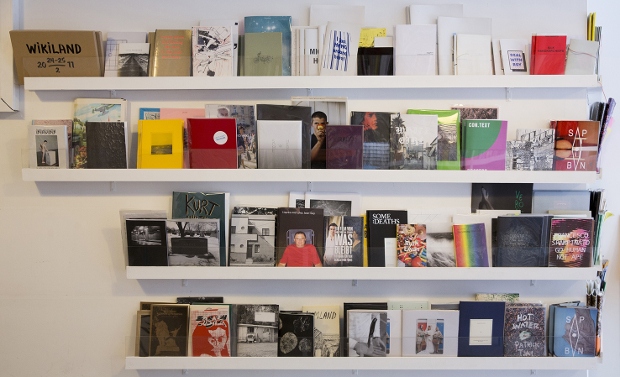Your guide to the East London zine scene

Shelf life: Ti Pi Tin art book shop in Stoke Newington is well stocked with zines. Photograph: Eleonore de Bonneval
“What’s a zine?”, people venture, confusion mingling with apprehension, as I begin that tricky task of explaining my enthusiasm for an obscure, self-published leaflet in the age of live-feeds, tweets and ubiquitous internet domination.
Punk, feminist, anarchist and eco zines have been an integral facet of counter- and sub-culture since the 1970s, particularly prominent in New York and other US metropoles. Short for fanzines – named for their dedication to one subject – zines are lo-fi, usually black and white (though often with colour covers), photocopied, self-published booklets that tend to have a print run of less than 100, and are often created by just one person. They are rarely profit-making enterprises, nor do they feature any advertising.
You’d think that the advent of the internet and the corresponding increase in e-zines might have negated the impact of DIY zines, but if anything people seem to appreciate the rare pleasure of holding actual paper in their hands. The internet has also facilitated like-minded members of zine communities to swap notes (and zines), and to spread the word on workshops, zine fairs and distribution.
In fact, I discovered my first zine fair through an internet stumble – and turned up one day at QZFL (Queer Zine Fest London) last December at Space Station Sixty-Five in South East London with no idea what to expect. A veritable mecca for DIY publications and an incredibly tight-knit, yet friendly community awaited: hundreds of zines and their makers showcasing their work on a variety of themes, including break-ups, transgender identity, mental health issues, zine-making, and meditations on feminism, identity, sex and love. Alongside homemade cake and quiche, zines were on sale for between 50p and around £4 (some for free), with free workshops and talks running all day.
Since that fair, nursing a long-harboured idea of creating an alternative publication for new writing as a kind of antithesis to women’s magazines, I have cautiously made my own first entree into zine-making. It doesn’t matter that I did not grow up with zines, that I don’t know much about how they are made. Zines are experimental in their nature, to played around with and adapted. There is something calming about sticking, pasting, collating and re-connecting with some basic creative modes.
Zines themselves, as well as zine fairs and festivals, are often quite transient, and so can be hard to keep track of. Since QZFL I’ve visited a great zine fair in Kilburn, organised by small-press OOMK – One of My Kind. London College of Communication, along with the Women’s Library, houses an excellent collection of zines which are well worth checking out.
In London, I can recommend Housman’s political bookshop in King’s Cross; Freedom Press bookshop in Whitechapel, founded in 1866 and still retaining its anarchist credentials; the small but zine-rich Book Art Bookshop, also in Shoreditch; and Ti Pi Tin in Stoke Newington for a more art-based zine selection. There are countless more which you will discover for yourselves – The London Bookshop Map is great for searching for different types of specialist bookshops.
The third East London Comics and Arts Fair is taking place on Saturday 14 June at Oval Space, with exhibitors of graphic art, comics, zines and a host of talks. It’s as good an introduction to the scene as any, with talks on comic strips, sustainable self-publication, binding methods and much more. Take a look at their website, and you may never look back from the cut-paste world of small-press publication.
To find out more about Phoebe’s Seven Deadly Sins-themed zine series, email undine.zine@gmail.com.
